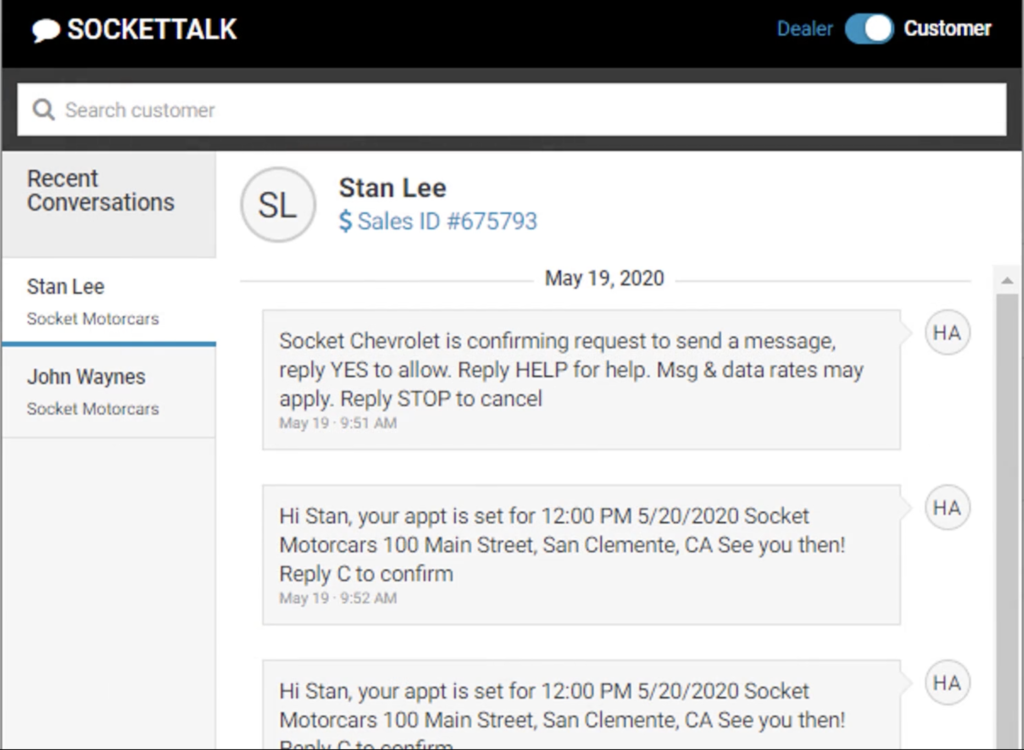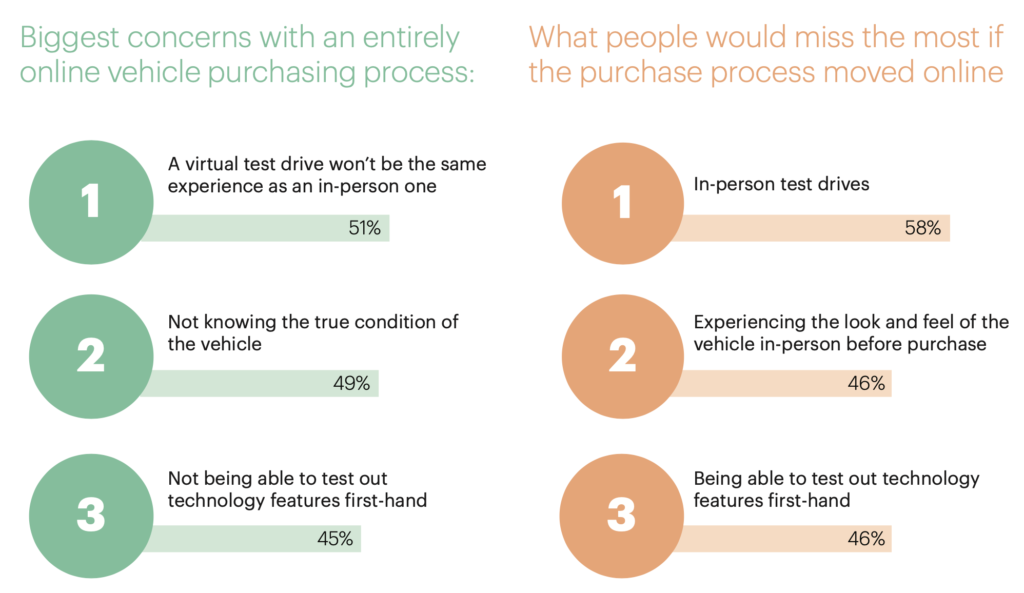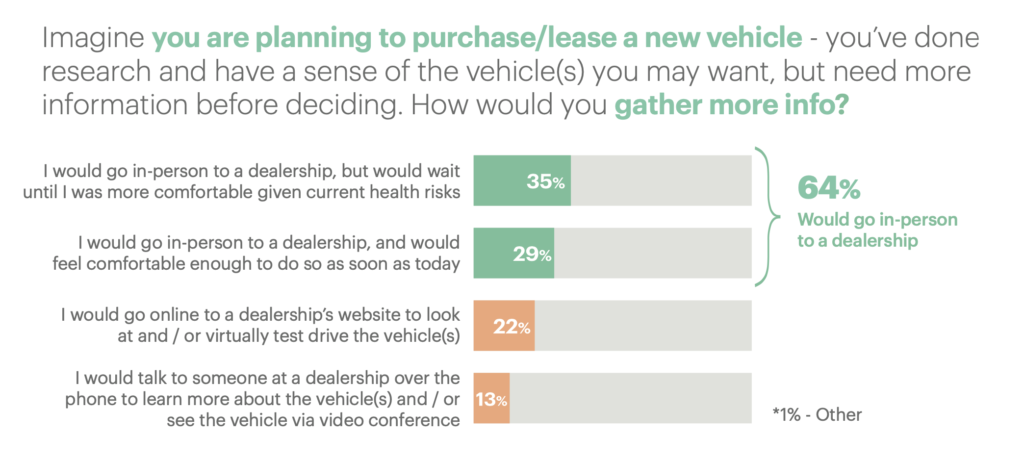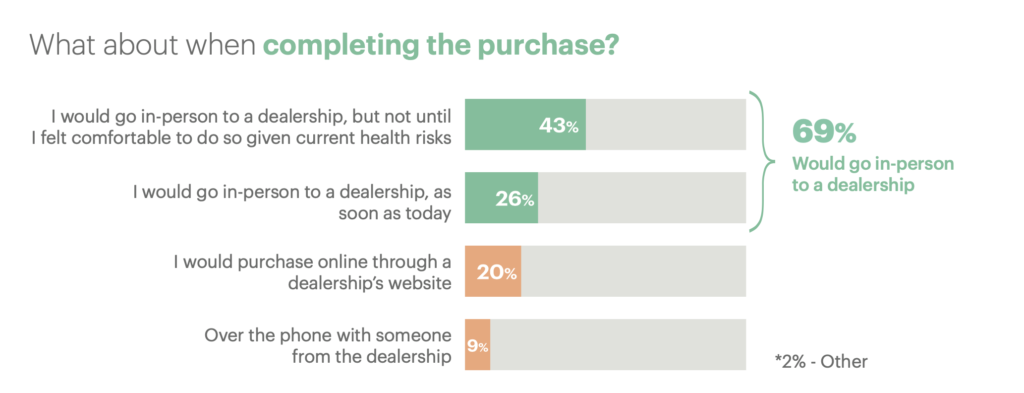The automotive industry is no exception to the transformative power of technology. Digital transformation, or integrating digital technologies into all aspects of business, has become necessary for independent auto dealers looking to thrive in today’s competitive market. Explore the significance of digital transformation and the challenges indie auto dealers face, and also discover a roadmap for embracing digital technologies to drive success.

The Current Landscape
Indie auto dealers often grapple with challenges such as limited resources, fierce competition, and changing consumer expectations. To remain competitive, embracing digital transformation is crucial. Consumers now rely heavily on digital channels for their research and purchasing decisions. Digital adaption is about staying relevant and meeting the evolving needs of the modern consumer. Embracing digital tools and strategies allows indie auto dealers to streamline operations, enhance customer experiences, and boost sales.

Key Digital Technologies
Here are some ways digital technologies can benefit your business:
- Online Presence and Website Optimization – The first step is to build a responsive and user-friendly website. Implementing effective SEO strategies ensures local visibility, attracting potential buyers actively searching for their next vehicle.
- Customer Relationship Management (CRM) Systems – Managing customer data efficiently and improving communication through CRM systems are essential for building lasting relationships. This fosters trust and increases the likelihood of repeat business.
- Social Media Marketing – Harnessing the power of social media platforms helps indie auto dealers connect with their local community, build brand awareness, and engage with potential buyers on a personal level.
- Inventory Management Software – Streamlining inventory processes and enhancing pricing strategies with specialized software ensures dealers can offer competitive prices and efficiently manage their stock.
- Digital Marketing and Advertising – Utilizing online ads and campaigns enables indie auto dealers to target their local audience effectively, increasing visibility and attracting potential customers.

Overcoming Challenges
Every indie dealer has experienced challenges to their business success. However, implementing digital technologies need not break the bank. Cost-effective strategies and long-term investment plans can make digital transformation accessible to indie auto dealers with varying budget constraints. Additionally, empowering staff with the necessary digital skills is critical. Collaborating with training programs ensures the entire team is well-equipped to navigate the digital landscape.

Implementation
Implementing digital transformation involves a strategic and systematic approach. Here are the steps:
- Assess current digital capabilities
- Define digital transformation objectives
- Create a digital transformation team
- Develop a digital transformation roadmap
- Invest in necessary technologies
- Ensure data security and compliance
- Focus on customer experience
- Employee training and change management
- Iterative implementation and continuous improvement
- Monitor and measure success

Future Trends
Exploring emerging trends such as artificial intelligence, machine learning, augmented reality, and blockchain provides insights into what the future holds for the automotive industry.
The path to success for indie auto dealers lies in embracing digital transformation. The benefits are clear – increased visibility, improved customer relationships, and a competitive edge in a rapidly evolving market. By adopting the right technologies and strategies, indie auto dealers can confidently navigate the digital landscape, ensuring a prosperous future in the automotive industry.
Ready to transform your indie dealership and accelerate toward success in the digital era? Talk to one of our friendly experts today to get started.
Dealer solutions and services on display at the Las Vegas Convention Center
Solera’s Vehicle Solutions business line, the leader in vehicle owner lifecycle management, is excited to present their latest dealer and OEM solutions updates at the NADA SHOW 2024 in Las Vegas from Feb. 1-4. This premier event offers automotive industry professionals an opportunity to explore groundbreaking technology and strategies for expanding their businesses. By revolutionizing and reinvigorating dealership operations, customer relationship management, marketing and digital advertising, and fixed operations, Solera’s dealer solution suite has the potential to change the game in the industry.
Visitors to the Vehicle Solutions’ interactive booth will have the opportunity to experience firsthand the game-changing technologies transforming the automotive industry. Here are a few of the exciting new products that Solera is presenting:
- RedCap Service Suite: This modular platform, designed for large-scale businesses, offers a comprehensive suite of solutions that integrates seamlessly with various dealership processes, including appointment scheduling, check-in procedures, lane walkarounds, electronic loaner management, digital payments, and other advanced features. This is set to revolutionize automotive fixed operations, boosting efficiency and profitability for dealerships nationwide.
- Peri by Solera: This innovative payment processing service is tailor-made for the automotive industry. It offers a sustainable approach that effectively lowers transaction fees for businesses of any size. Peri’s goal is to bring about a positive change in the merchant services sector, which is frequently burdened with hidden fees and complex terms and conditions. The most noteworthy feature of Peri is its potential to reduce transaction fees by up to 35% compared to industry standards.
- ServiceAgent AI powered by Stella: The state-of-the-art inbound call center solution will soon leverage artificial intelligence to provide an smart, efficient, and personalized call center experience that redefines customer engagement in the automotive industry.
- AutoMate and DealerFenix Partnership: Solera’s partnership with DealerFenix brings unprecedented efficiency to dealership operations by integrating DealerFenix’s expertise in digital retailing with AutoMate’s innovative dealership solutions. This collaboration aims to enhance the overall customer experience.
- Marketing Platform Enhancements: Solera’s commitment to excellence extends to its state-of-the-art marketing platform under the AutoPoint brand. On AutoPoint’s OnDemand platform, dealers can engage with potential customers in just a few minutes through targeted marketing campaigns using the new website visitor ID system.
“Solera’s Vehicle Solutions team is extremely proud to showcase our latest innovations, cementing our pledge to revolutionize the automotive sector,” declares Tony Graham, Executive Vice President. “Our pioneering solutions promise to redefine the terrain of dealership operations with a steadfast dedication to furnishing state-of-the-art solutions and services that not only fulfill but surpass the changing requirements of our clientele, while setting new standards for productivity, financial gains, and customer satisfaction. Join us for discussions, demos, and a glimpse into how our technology empowers dealerships to thrive in a dynamic market. We can’t wait to see you at NADA, where innovation meets inspiration!”
Attendees and media representatives are invited to visit Booth 2901W at the 2024 NADA Show to experience these groundbreaking services and solutions firsthand. Solera’s Vehicle Solutions team will be available for presentations, demonstrations, and discussions regarding their comprehensive suite of solutions.
To learn more about Solera’s Vehicle Solutions or to secure a spot while at the NADA Show, visit www.solera.com/nada.
The Significance of Regular Statement Reviews
Reviewing your merchant services statements for your automotive business plays a vital role in cost management, competitive edge maintenance, security and compliance assurance, and enhancing the overall customer experience. Periodic assessments empower you to make knowledgeable decisions that can significantly benefit your business.
Important Factors in Each Statement:
1. Expense Management: Understanding the various fees linked to your merchant services is crucial for efficient expense management. These charges encompass transaction fees, monthly expenditures, and other expenses. By carefully examining your merchant services, you can identify areas where potential excess payments may occur and take corrective actions.
2. Fee Adjustments: Keep a lookout for new fees or modifications in existing fee structures, as these can arise with numerous service providers. Regular evaluations ensure that you remain informed, averting unexpected financial surprises.
3. Competitive Pricing: Securing the most favorable rates can result in substantial savings for your business. Rates may fluctuate among providers, so periodic assessments enable you to gauge whether you are still receiving competitive pricing. A simple calculation—involving dividing total processing fees by the total processed volume—unveils the percentage representing your overall cost of accepting credit card payments.
Introducing the All-New Peri by Solera
Explore Peri by Solera, an innovative merchant services credit card payments platform for credit card payments crafted to offer competitive rates and cutting-edge security specifically tailored for automotive enterprises. While merchant services statements may appear initially intricate due to the variety of charges and fees linked to credit card processing, breaking them down into simpler steps can enhance their comprehensibility.
Mastering the Art of Statement Analysis
Here are a few ways to interpret a merchant services statement:
1. Account Details: Begin by identifying the statement date and ensuring that your business name, merchant identification, and contact details are accurate.
2. Transaction Overview: Take notice of the total sum processed, the quantity of transactions, and any instances of chargebacks or refunds.
3. Fee Summary: Pay close attention to the fee section, encompassing:
- Interchange fees: Fees established by credit card associations (Visa, Mastercard, etc.) passed on to your merchant account provider.
- Processing fees: Costs from your merchant account provider for processing transactions.
- Monthly fees: Any monthly service costs, such as statement or gateway fees.
- Other fees: These may involve fees related to chargebacks, PCI compliance, and other services or penalties.
4. Payment Deposits: Understand the amount of money deposited into your business bank account after accounting for processing charges and other deductions.
5. Chargebacks and Returns: Scrutinize any instances of chargebacks (disputed transactions) or refunds and how they were managed.
Optimize Your Potential Savings Today
Regularly assessing your statements is crucial in detecting disparities and optimizing your payment processing expenses. By comparing past statements, you can identify substantial changes in fees, transaction volumes, or chargebacks.
Peri by Solera is here to assist automotive businesses in saving money. Reach out to a Solera representative today to ensure you’re not missing out on potential savings. Contact us during business hours at 888-974-2952 or schedule a meeting.
Did you find this article helpful? Find more great content at dealersocket.com/blog and solera.com/blog.
Dealerships often face significant challenges when it comes to credit card payment processing. In the automotive industry, transactions can vary greatly in size, from minor sales to major purchases, leading to issues with processing fees. Some providers charge higher percentages for larger transactions, affecting the dealership’s profitability or necessitating higher costs for customers in a fiercely competitive market.
Understanding Dealers’ Payment Processing Challenges
Efficiency and reliability in payment processing are pivotal for dealerships. Delays or technical glitches can disrupt operations and impact customer satisfaction. If payment terminals and point-of-sale (POS) systems aren’t tailored to the specific needs of dealerships, it can result in costly disruptions and potential lost business opportunities.
Ten Common Pain Points in Dealership Payment Processing
Let’s explore ten common pain points that independent and franchise dealerships encounter with their payment processing services:
- High Processing Fees: Many merchant services providers impose substantial processing fees for credit card transactions, particularly on larger sales.
- Lengthy Settlement Times: Delayed settlement times can pose cash flow challenges, with providers taking days or even a week to deposit funds from credit card transactions.
- Equipment and Technology Issues: Reliable payment terminals and POS systems are pivotal for smooth transactions. Frequent malfunctions can disrupt business operations and negatively affect the customer experience.
- Lack of Industry-Specific Features: Some providers neglect to offer features tailored to dealerships’ needs, such as invoice management, flexible payment options, or seamless integration with existing management software.
- Inadequate Customer Support: Prompt and efficient customer support is essential for resolving payment-related issues quickly. Frustration arises when providers lack responsive support or fail to address concerns promptly.
- Security Concerns: Dealerships handle sensitive customer data. Inadequate security measures can expose them to data breaches and erode customer trust.
- Hidden Costs: Some providers may hide additional costs, such as monthly fees or PCI compliance charges, impacting the dealership’s bottom line.
- Limited Payment Options: A lack of diverse payment options can deter potential customers and restrict revenue streams.
- Compliance Challenges: Dealerships must adhere to industry regulations. Non-compliance can lead to legal issues and fines.
- Inefficient Reporting: Inadequate reporting tools make it challenging for dealerships to track and analyze payment data for business insights.
These challenges underscore the importance of selecting a provider that offers competitive rates, reliable technology, industry-specific features, robust security, and responsive customer support to address the distinct requirements of independent and franchise dealerships.

Meet Peri by Solera: Revolutionizing Payment Processing
Introducing Peri by Solera – a payment processing service designed to help dealerships reduce costs on every transaction. It enables businesses to swiftly adopt or enhance their payment options with lower fees, bolstering their competitiveness in today’s market.
With Peri, dealership owners gain access to reliable customer support, ensuring that any technical issues related to accepting payments online are promptly resolved. This guarantees no delays in getting paid by customers, providing peace of mind to dealership owners.
Discover how Peri merchant services can revolutionize your dealership’s payment processing experience, boost your competitiveness in the industry, and address these pain points head-on.
Learn more about Peri by Solera today.
Did you like this article? Find more great content at dealersocket.com/blog and solera.com/blog
Independent car dealerships must remain competitive compared to other independent dealers in their area and large national chains with big budgets, a strong brand identity, and access to a nationwide inventory. It can be tough out there, but many independent dealerships are not only competitive, but they thrive.
How do they do that? They pay attention to industry trends, understand what customers want, and actively work to stay competitive. Here are some ways they do just that.
Industry Trends in 2023
While the used car boom that sent prices sky high may be winding down, there is still a large demand for quality used vehicles. With the cost of new cars reaching new highs, interest rates rising, and supply chain woes still plaguing the industry, used cars still rate as an excellent choice for many consumers.
Once seemingly overvalued, older cars will take the biggest hit, while late-model cars will hold steady or decline slightly, mirroring the trend for new cars. While EVs are sparking more excitement, long wait lists for new vehicles are still growing, so the opportunity to sell used EVs is enormous.
What do customers want?
According to a survey conducted by the National Independent Automobile Dealers Association (NIADA), customers want many of the same things they have come to expect from independent dealerships: transparency, honesty, and fair pricing. But that’s not all.
They also prioritize quality vehicles, a wide selection of inventory, and knowledgeable salespeople who can help them find the right car for what they need and that fits within their budget.
Along with those things, customers value convenience and a positive buying experience, including easy financing options, reliable service and maintenance, and a welcoming atmosphere. Essentially, they want a positive and professional experience. How does this translate to what you do every day to stay competitive?
8 Tips to Stay Competitive
It’s great to know what industry trends are and what customers are looking for, but it is also essential to take action to stay competitive. Here are eight things you can do.
- Offer a wide variety of vehicles: Customers like choices, including new popular hybrids or EVs. But they also like a variety of prices, models, and years to choose from. Don’t be afraid to be creative or even niche down and specialize.
- Build a robust online presence: It’s a digital world, and many customers pre-shop online. Be sure to list your vehicles and have good, professional-looking photos.
- Provide excellent customer service: This includes your parts and service departments if you have them. Customers remember the image you portray everywhere, so be sure that customer service runs through your culture.
- Focus on quality: Ensure that your dealership’s vehicles meet high-quality standards by only offering vehicles with clean histories accompanied by thorough inspections.
- Offer financing options: Just like a variety of cars, customers like a variety of financing options. Be sure to offer choices for those with everything from excellent to below-average credit. The more choices your customer has, the better.
- Embrace technology: Car dealerships can use technology to their advantage with advanced dealer management software like IDMS, which is built specifically for independent and BHPH dealers to help them increase revenue, better manage inventory, improve sales processes, and maximize productivity.
- Offer unique services: Find what sets your dealership apart from others in your area by offering specialized services and options. For instance, LoJack Go from GoldStar gives dealers connected vehicle technology for consumers by offering easy digital payment options, which minimizes delinquencies and increases dealer collections. Choose a niche where you can focus your attention and open different departments to better serve your customers.
- Attend local events: Attend local events and trade shows, hold or be a part of offsite sales, sponsor local non-profits and events, and more.
While it can seem like there is a lot of competition at times, this fact helps you focus on ways to improve your dealership, which benefits you and your customers in the long run. This relates to everything from your sales team to your parts department and service desk.
To learn more about the competitive advantages offered by Solera, visit www.dealersocket.com.
Solera solutions help dealerships out sell, out service, and out perform the competition
Every year, the annual National Automobile Dealers Association (NADA) show attracts thousands of auto dealership employees. They look to network, learn emerging industry trends, and find out about the latest technology that can help them streamline operations and improve improve CX (customer experience).
And we will be there too! We are exhibiting at the Kay Bailey Hutchinson Convention Center from Jan. 26-29th. There we will demonstrate our industry-leading solutions that help dealerships drive sales, reach more customers, and improve profit margins.
Solutions Built for Dealers
Whether it’s marketing and sales, financing and titling, or service and repair, our solutions help:
- Optimize every marketing dollar: Our best-in-class omnichannel marketing platform and CRM help dealers optimize investments across traditional and digital channels. They also support both sales and service business objectives. And new integrations give dealerships additional outbound marketing channels to better reach customers.
- Connect with customers: The DealerSocket CRM is a comprehensive customer management solution that converts and retains customers through the sales and service lifecycle while increasing revenue per transaction. The industry-leading CRM doesn’t only drive sales, but also connects all systems, simplifying and enriching the experience for both your team and customers.
- Maximize customer pay spend: MultiPoint Inspection is your total shop efficiency solution. It enables your team to optimize processes, link workflows across all fixed operations functions, and eliminate wasted time by enabling real-time communications visibility into operations.
- Stay on top of inventory: Inventory+ keeps inventory fresh by optimizing your vehicle mix, buying and selling vehicles at the right price, and trading with sister stores to stay aligned with sales trends at your dealership. Inventory+ also provides car dealers data based on real-time insights to help them make faster, better decisions.
- Boost profits: The combination of Inventory+ and CRM helps maximize your business outcomes and optimize your processes. You can then better identify efficiencies and manage inventory and incentive investments.
- Elevate dealer websites: Now infused with DealerSocket’s data platform, DealerFire sites delivers fast, sleek websites that are easy to build with no coding required. Powered by Engine6, these websites are fully responsive and are built to perform seamlessly on mobile devices. Thereby, driving more traffic, more leads, and more sales.
Why Meet with Us at NADA 2023
First and foremost, our dealership solutions streamline operations and workflows. But they also provide actionable insights, improve CX, and keep customers engaged with their dealerships. To find out more about how these solutions can accelerate your dealership’s success, visit our NADA page.
Selling vehicles isn’t like it used to be. In the past, you could depend on a steady flow of potential car buyers after placing a few ads on the radio or in print. Today, customers take a more active role in the buying process. Instead of visiting the dealership, they’re doing online research. That’s why it’s imperative to have a marketing strategy—especially a digital marketing one—to guide potential consumers to your car dealership.
In this guide, we’ll explain what digital marketing is, discuss why it’s important, and provide several digital marketing strategies to help you reach more customers and boost your sales.
What is digital marketing?
Digital marketing is a multifaceted approach to promote services, goods, and brands using the internet and electronic media. It relies on various channels, such as mobile apps, websites, social media platforms, and instant messaging, to improve customer engagement.
Essentially, if a marketing campaign involves online or electronic communication, it’s digital marketing.
Why is digital marketing important for car dealerships?
There are many benefits to implementing a digital marketing strategy for your car dealership. Here are some of the advantages:
Increase online visibility
The first organic (unpaid) search result in Google Search has an average click-through rate (CTR) of about 28%. This means that if your website link is in this top spot, you are likely attracting more potential customers.
If your car dealership relies only on conventional marketing strategies, it’s time to make changes. While radio, TV, and billboards play an important role in marketing and sales, their impact has lessened in today’s environment. Consumers now spend most of their time online, so engaging with them there will boost your sales.
Personalize the experience
Digital marketing allows you to market the right products to the right customers. And tailor your actions to provide better value to your audience. For instance, when a potential car buyer visits your site, allowing them to personalize their experience will help you better meet their needs. This may be through a chatbot feature, newsletter subscription sign-up, or by publishing relevant and browsable content so viewers can find answers to their questions and solutions to their problems on their own.
Engage with customers directly
Social media is a great platform to ensure engagement with your potential buyers or target audience. Social media platforms can help you engage potential buyers and create a community where they can ask questions, voice their concerns, and be part of a conversation.
By responding to specific questions, your car dealership can be seen as a knowledgeable and trustworthy market leader. This can lead to potential customers being more likely to buy a car from you, as a bond of trust has been established—a bond that may be lacking between your competitors and potential buyers.
The fact that you can immediately and directly engage with your target audience allows for valuable feedback opportunities from prospective buyers. This allows you to continuously improve your digital marketing strategies as your target audience evolves.
5 Digital Marketing Strategies Your Car Dealership Should Consider
Here are some of the best digital marketing strategies to help you attract and retain today’s connected car buyers:
1. Email marketing
Email marketing continues to be one of the most effective digital marketing strategies. In fact, it has the highest return on investment of all kinds of marketing, averaging about $42 in return for every $1 spent.
And personalized emails convert better. Research conducted by G/O Digital revealed that about 35% of car buyers prefer emails based on their interests. Further, 28% said they would click on a car dealership email if it includes a model, color, or style they’re interested in.
With today’s sophisticated data sets, you can segment prospective customer audiences based on a wide range of selects, including their current car’s make, model, and Black Book value, those most likely “in the market” for a new car, and other demographics, such as hobbies, income, and more.
2. Social media marketing
A study conducted by the CMO council revealed that 23% of buyers talk about purchasing a new car on social media and about 38% say they’ll consult social sites prior to purchasing. So, if you’re not posting and advertising on social media platforms, like Pinterest, Instagram, Twitter, and Facebook, you’re likely missing out on opportunities.
An effective social media marketing strategy includes sharing useful, relevant, and interesting content on various social channels several times a week. It also includes engaging in conversations on your pages, posting inventory and happy customer photos, responding to reviews, and making your dealership contact details easily accessible.
3. Search engine optimization
Search engine optimization (SEO) refers to the process used to improve the viability and visibility of your website through online searches. Implementing good SEO strategies will, in time, increase the likelihood of your website being served to people searching for car dealerships. According to Google, 95% of car buyers use digital research as a source of information. In fact, twice as many begin their search online than by visiting a dealership. So if your website isn’t performing well and isn’t one of the top displayed sites on search engines, you’re losing 95% of potential opportunities.
Perhaps the two most important tactics of a strong SEO strategy are high-quality, keyword-focused content publication and link building. While it may take time for search engines to recommend your website over others, you will no doubt improve the quality and quantity of your site traffic, thereby increasing the likelihood of your website getting discovered by people looking for a new car.
To create relevant content using the right keywords, you must understand your target audience. For example, if you want to attract potential buyers searching for California car dealerships, consider including terms like “automotive car dealers in California, “auto car dealership in California”, or “car dealerships near me” within blog posts or on your website pages. But to really improve the quality and relevancy of your content planning, use a keyword research tool to best identify and discover new industry-related keywords. Many free and easy tools exist, including Spyfu and WordStream, and help you identify the right keywords.
4. Mobile optimization
Mobile devices changed how buyers research cars they want, as well as how they discover new or different vehicles. A study commissioned by Facebook revealed that 71% of consumers use their phones during the vehicle purchasing process, and about 58% said that in the future they only intend to use their smartphones for all their vehicle research.
A mobile-first and responsive dealer website is more crucial than ever. Google and other search engines rank websites on the overall page experience. This includes, among many other factors, the usability of a website on a cellphone and the page load time. Ensuring your website is optimized for mobile devices increases your SEO rankings and chances of gaining new customers.
Here are a few tips to implement yourself or pass to your web developer:
-
Test your website: Consider testing your site pages on several devices to learn page loading times, whether the content is legible and accessible, how well the design and features work on smaller screens, and if the navigation is easy to use.
-
Use CSS to make your site responsive: Responsive websites automatically and smoothly adjust the layout and flow of content based on the size and resolution of the device. You can use CSS to implement media query ranges, also called responsive breakpoints, so browsers load different webpage layouts depending on the device.
-
Choose a responsive website theme: Because responsive sites perform better on all devices, consider installing a new responsive theme when designing a new site. To determine if a theme is responsive, access a demo before installing it. Theme demos often include previews of how pages will render on different-sized screens.
5. Video marketing
Video marketing refers to the strategic use of videos to promote and inform about services or product inventory and to boost engagement on digital and social channels.
About 66% of marketers say they’ll either increase or maintain their spending on video this year. By its very nature, video marketing better captures viewers’ attention. It’s also more engaging than other mediums, such as imagery and text. In fact, according to a study by Google, 64% of people who used YouTube while purchasing a car were influenced by it. That’s more than magazines and newspapers.
Here are a few tips on creating effective video marketing at your car dealership:
-
Know what your audience wants in the video: When you organize each video, consider what your audience would like to watch. For example, if you’re filming a tour of your dealership, consider asking yourself questions like, “What areas of the dealership are customers interested in?”, “What do customers want to know about our dealership?”, or “What questions do buyers have about our dealership?”. When planning each video, always keep customer needs top of mind.
-
Showcase more than your dealership’s inventory: While your auto inventory may be your dealership’s focus, buyers want to know more about your dealership’s values, policies, team, and how you can help them after the completed sale. Instead of only filming walk-throughs of every new vehicle, consider capturing everyday life on the lot and introducing key team members on the floor and in the service department. You’ll educate and build relationships with future customers.
-
Stay on brand: Is your dealership customer-centric and friendly? Or are you known for a more serious buying experience? Whatever the brand personality, make sure to highlight this when recording. Keeping a consistent brand voice allows your dealership to capitalize on its brand reputation and share it with new audiences.
-
Keep it short: People know no longer have the interest or attention span to watch several five-minute videos in a row. Thus, when creating video, keep it short. Videos that are up to two minutes long get the most engagement. After two minutes, there’s a significant decrease.
Accelerate your car dealership’s operations now
Understanding your buyers is the first and most important step in developing successful digital marketing strategies. Through a combination of social media, email, website, and video marketing tactics, you will improve your car dealership’s online visibility and reach a more engaged, interested audience.
If you want to improve your digital marketing strategy, consider using AutoPoint marketing. This robust suite of solutions connects all the dots of the customers’ vehicle lifecycle. It offers every tool you need to promote sales, launch effective digital marketing campaigns, supply proper documentation, provide maintenance support, and improve customer retention. Let us work with you to create a digital marketing strategy so you can rise above the competition.
A successful marketing plan is critical for the growth of your dealership. Coming up with a successful marketing campaign for the dealership website can be tricky. The automotive industry is highly competitive, and its trends constantly shift.
To that end, here are some of the best actionable tips to make your car dealership marketing campaign more advantageous.
1. Optimize Your Efforts at SEO
In today’s market, many car buyers begin their journey online. Increasing your Search Engine Optimization (SEO) can increase the traffic you get to your dealership website, and this can gain you new customers. You need to ensure that your dealership makes the first page of results on both Google and Bing. Choosing your keywords carefully, ones that have a rather high volume of searches with low competition is one method of doing this.
Another method of increasing your SEO rankings is to list yourself in a variety of qualified directories. This can increase your chances of being located when customers search for local dealerships.
You might also begin a blog for the website or add a few new pages that will provide your customers with useful information. Including content helpful to car shoppers will drive even more traffic to your site while also increasing online leads. Some topics you might cover include:
- Pros and cons of each model
- Sales tactics you shouldn’t fall for
- How to change your oil
Focused content that adds value to your customers or intended customers can help drive traffic to your dealership page.
2. Blog for a Successful Marketing Campaign
Publishing content that’s educational on your blog is a great form of digital marketing that can help you ensure that you remain relevant to your customers while also boosting engagement on your website. You might utilize a blog in a variety of ways, but one of the best ways is to build trust with prospective car buyers.
A blog post can assist you with streamlining the process of buying a car as readers seek out the various car dealerships in their area. Knowing this, you can use your blog to build a relationship with them.
When they learn how you care for your community as well as that you’re an industry expert, your audience can gain confidence in knowing that they’ll get excellent customer service from you, both before and after the sale.
3. Emails to Your Target Audience
Email marketing continues to be a great marketing strategy for car dealerships that want to remain in touch with their clients. Consider this — how long have you had the same address for email? Your target audience tends to keep their email addresses for quite a few years too. Customize your strategy for email marketing based on services you offer, the seasons, or other helpful information necessary to car buyers. This can even include service reminders and blog posts, like:
- Is it time for that oil change?
- Winter/summer is coming, get your heaters/air conditioners checked.
- Check out the new models for 2023!
Emails like the ones above will remind customers to have their service work done, or come see the new models — either one of which will bring them into the dealership, giving you an opportunity to make a sale.
4. YouTube
Have you ever found yourself searching for a video about something you were thinking about buying? Your customers do this too. Before they visit your lot, clients might be searching for videos about a vehicle they’re interested in or even your dealership itself. YouTube is quite an influential tool for shoppers. The number of views for those videos that show features, test drives, and walkthroughs is quite high. Because viewers tend to use mobile devices for this as opposed to computers, your videos also need to be mobile-friendly.
5. Social Media
This can be a massive influencer when it comes to millennials and purchase decisions. Having an active feed means that you can notify your followers when you get new stock, which can be an incentive for them to visit, and it can help your business seem active and busy. It’s also a fantastic way to form relationships with both current and potential customers.
Facebook, often the top choice for many companies looking to utilize social media, is a spectacular place to begin. It offers the most adult users, and they tend to be the target audience for car dealers. Be sure you’re posting a variety of content, including testimonials, articles, videos, and more.
Twitter utilizes short posts that consist of only 380 characters or less. This is the ideal platform to advertise any current offers or update customers when you get new inventory. Make sure you include engaging photos to draw a bit more attention to what you’re posting.
6. Referral Program
You may be tempted to focus entirely on the vehicle side of your dealership, but you have to keep in mind that the customer service side of things can also help you when it comes to driving sales.
You might consider a referral program in order to encourage your customers to share their experience with your dealership among their family and friends. This can help you grow your lead database and your business overall.
One great way to do this is by using a loyalty program. This will reward customers for telling their family and friends about your business. It’s also a fantastic opportunity to get even more qualified leads in to talk with your salespeople about purchasing a new vehicle, all while helping those same salespeople earn more money.
Put Your New Successful Marketing Campaign to Work
An effective marketing strategy for car dealerships will increase sales with the generation of leads. It will engage with your existing customers in a way that’s meaningful and solidify the brand in the minds of the target audience.
Coming up with an actionable marketing strategy for your automotive dealership will take quite a bit of research and time.
Optimizing your efforts at SEO, creating a successful email marketing campaign, posting informational videos on YouTube, blogging about your business, being active and engaging on social media, and using a referral program can all help you grow your business.
Use these tips to add more sources for new leads and customers, encourage repeat business, and most of all, grow your dealership.
The customer experience (CX) is the driving force of any successful business. More than ever, providing customers with seamless service and access to information is vital to attracting and retaining valuable consumers. For that reason, franchise and independent dealership websites must focus on the customer experience by reflecting this cultural shift and offering auto buyers a variety of ways to find the information they seek.
Customer Experience is King
According to recent data from Qualtrix, 8 out of 10 people feel customer experience should be improved across products, prices and fees, customer service, and ease of use. Brands risk losing9.5% of their revenue on average due to poor customer experience. And more than 50%of customers say they are likely to leave a brand after a bad customer experience.
How Dealer Website CX Helps Customers
You will lose potential and existing customers if your website is clunky, outdated, or hard to navigate. People have many choices, so optimizing your website experience, for both the car buyer and service client, is key to generating new revenue and word-of-mouth recommendations.
Here’s what to look for:
Make Website Easy to Use
The first –and most important– element of a successful dealer website is that it’s responsive, meaning it works the same on any device. Most consumers initially research purchases from smartphones, so your branding must be consistent across platforms. Ensure it’s easy to search, provide chat options and use eye-catching elements that are visually exciting. You are selling your products and services here, and this is your first chance to make an impression before a client ever steps through your doors.
Offer a Variety of Resources
Giving your customers many ways to learn about your products and automotive services on their own can only benefit you. A rich and compelling content offering will allow potential and current customers to explore and find answers to their questions on their own before they meet with you in person. Giving them the information they are looking for helps establish you as a valuable resource, even if they don’t buy anything this time. You can offer this by creating an extensive knowledgebase on your dealership website with testimonials, product videos, and articles on trends or new releases. Customers will check your social media for reviews, so stay on top of those channels. And offering a “Get a Quote”/”Build Your Vehicle” page allows the consumer to envision how the vehicle will work with their lifestyle.
Drill Down on Data & Information
Offering a vibrant car search inventory is another way to elevate the customer experience. Consumers like to do their research, so provide different ways to imagine themselves in one of your vehicles. Here are a few suggestions:
- Create a “Lifestyles” page, sharing options for commuters, families, outdoor enthusiasts, and eco-friendly options.
- Pricing/financing calculators are popular features
- Share stats/trends on your vehicles
- Highlight current offers
- Repeat calls-to-action throughout the pages on your site
- Add contact forms to each page to capture user information
Take Advantage of Insights to Improve the Customer Experience
Finally, identify the most utilized features customers visit and mine them for data and insights. And don’t fall back on updates. Continue to innovate and improve your site based on what you see customers engaging with and visiting the most. Crafting a rich and engaging dealer website will elevate your customer experience and set you apart from your competition. Find out more about how to create a new or optimize your current independent or franchise website today!
Learn More About Our Best-in-Class Solutions
CRM: Critical Dealer Tool
Why is CRM not included in the digital retailing discussion?
While there is plenty of attention on digital retailing during the pandemic, there has been little attention paid to how CRM help dealers navigate this period of social distancing. But it’s understandable. The CRM isn’t the new shiny object like digital retailing, and COVID-19 certainly reignited the digital-retail discussion. However, there’s no doubt of the importance of appointment-setting during COVID-19, especially for dealerships located in markets where sales were limited to appointment-only. It’s an art that predates the CRM, but, thanks to that important front-end tool, appointment-setting has become a science for some operations.

What often gets overlooked is just how often CRM providers update this critical tool. In DealerSocket’s case, the cadence is every two weeks. And the focus of late for DealerSocket is appointment-setting, with texting now a key component, thanks to dealer feedback.
Auto Buyers Prefer Texting
Recently, a California dealership customer began sending every internet lead received an initial opt-in text. If there was no response within a few minutes, the following text message — one that garners a response 70% of the time — was sent, “We just received your internet request, and we have a few questions. Do you prefer a call or a text?”
That dealership sent and delivered 26,617 texts.
Then there’s Rashad Tillman, who manages a centralized BDC for a two-rooftop independent group in Southern California. With a keep-it-simple approach, he operates under the belief that a successful road to the sale requires five yeses from a customer. The use of DealerSocket’s SocketTalk texting tool usually accounts for two of those yeses, starting with the opt-in text.
“All we’re looking for is a reply. Once we get one, we’re in control,” Tillman says. And once a customer opts in, the following text is sent, “’We received your lead for the [make and model], which we have available. Do you have time today to test-drive the vehicle?’”
“That usually results in a reply,” Tillman says. “I’ve been working with DealerSocket’s CRM for seven years now, and I figured out real early that texting is now the primary form of communication. So, we try to eliminate as much conversation as possible.”
In one month, Tillman’s 20-member team sent and received 59,402 text messages through the CRM’s SocketTalk texting tool, with two members logging 2,900 sent and received texts for the month. Tillman notes that texting accounts for 80% of his department’s activity when working a lead, which is he says knowing how to configure DealerSocket’s CRM dashboard correctly is critical to making sure no opportunity falls through the cracks.
Better Manage Leads and Opportunities
With DealerSocket’s CRM, managers don’t have to dig into the solution’s reporting tools to keep tabs on their team’s lead-handling activities. Merely creating a dashboard widget for web leads allows managers like Tillman to keep tabs on every opportunity and every text or email exchange. That’s where he says most managers go wrong. They have the talent and skills, but they resist to allow technology to augment their abilities.
In fact, the use of technology is how managers like Tillman are keeping their dealerships in the game when today’s car buyers are shopping more brands, more vehicles, and more dealerships than those car-buyer studies predicted they would four to five years ago. The latest data on that front comes from a study commissioned by Urban Science, which showed that the average car shopper is considering 2.6 brands, visits 2.5 dealerships, and submits, on average, three lead forms.
Regardless of whether your BDC staffers or sales teams are selling appointments or demonstrating to customers a willingness to be shopped to win their business, converting a lead into an appointment requires a CRM-driven process that doesn’t end once the customer says, “yes.”
The best part of a CRM-driven appointment-setting process is that it can be automated every step of the way. In the case of DealerSocket, our CRM’s Campaign Manager allows you to assign your operation’s best word-tracks to a BDC staffer’s scheduled response to an inquiry. It can also automate appointment reminders, confirmation communications, and follow-ups. Then there’s the CRM’s Business Rules automation tool. This allows managers to initiate activities such as vehicle prep and enrollment of customers into appropriate campaigns.
With this, CRM should be included in the digital retailing discussion. When a customer structures a deal through your website’s digital retail tool and submits their information, the question dealers need to answer is, “what does the experience look like when it does?”
We continue to think about all of you, our customers and partners, during this difficult time. This pandemic has caused deep challenges across our industry and for all of us, and I hope you know that DealerSocket continues to be here for our dealers. Our goal has been to strike the right balance between being prepared for our dealers and the market when our industry recovers and offering discounts to help our dealers as much as possible during this difficult time.

We will get through this, and we will get through this together. We are committed to fighting through this with you. We are beginning to see the first signs of positive trends as we climb out of the depths of the COVID-19 pandemic, and this has us all hopeful for the future.
In April, we heavily discounted our software for our dealers. In addition to our discounts in April, we have decided to offer the following DealerSocket billing reductions for May for all of our dealers:
- 25% off DealerSocket CRM
- 25% off RevenueRadar, our data and equity mining tool (see note below)
- 50% off Car Wars
- 25% off Inventory+
- 25% off DealerFire websites and PrecisePrice digital retail (see note below)
- 15% off IDMS
- 15% off Auto/Mate DMS
We have already sent out our May invoices, so next week you will receive a credit memo for the above discounts. With that said, similar to our discount package last month, there are some basic qualifying terms listed below.
In addition to these discounts in April and May, DealerSocket continues to offer our customers several promotions and free months of certain software products to help you navigate this crisis. Our offers include promotions for:
- Precise Price digital retailing
- Inventory+ Absolute Sourcing and New Car functionality
- Delivery Test Drive Scheduler
- Digital Credit Application
- Auto/Mate Remote eDeal
Since we are adding promotions and various resources for dealers often, please view DealerSocket’s latest information by clicking here, and, as always, please feel free to reach out to your Customer Success Manager with any questions or if we can help in any way:
If you are not yet an Auto/Mate DMS customer, I hope you know that we can reduce your DMS bill significantly during these challenging times as well as into the future by switching to Auto/Mate DMS. We have several bundled packages that include our Auto/Mate DMS product combined with other DealerSocket products to support you.
Thank you for partnering with DealerSocket. I hope you know how much we value and appreciate your loyalty, partnership, and your business.
I wish you, your families, and your team members health in these unprecedented times.
Sejal Pietrzak
CEO and President
DealerSocket
[email protected]
Details regarding our COVID-19 relief package:
- The fee reductions above represent discounts to the monthly subscription amounts by DealerSocket and not third-party products and fees such as DMS integration fees, books fees, and other transactional fees.The discounts above apply to customers that are current with their DealerSocket account.
- Note: OEM programs for websites, equity mining, and digital retailing offerings will be subject to working through OEM partners.




